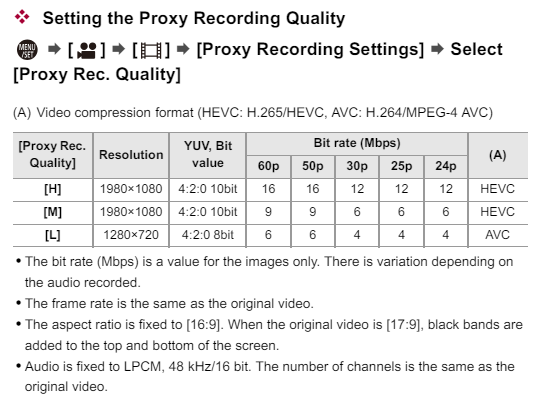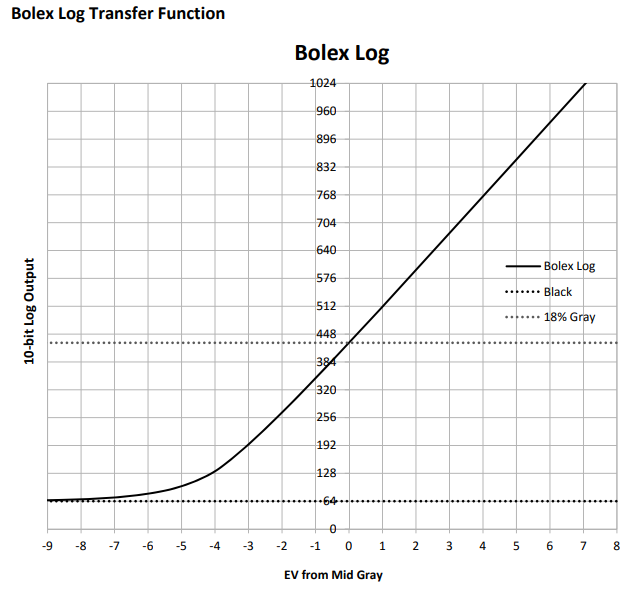
ac6000cw
Members-
Posts
684 -
Joined
-
Last visited
Content Type
Profiles
Forums
Articles
Everything posted by ac6000cw
-
If it was a real working 16mm film camera, I don't think it would be an ENG (Electronic News Gathering) lens, as they are designed for professional portable video cameras (which in the late 1970s would have been triple vacuum tube image sensor cameras using a dichroic colour splitting prism, thus having a long flange-to-sensor optical path). But of course in the movie it's basically a prop, so doesn't have to be a working camera.
-
Panasonic S5 II (What does Panasonic have up their sleeve?)
ac6000cw replied to newfoundmass's topic in Cameras
I did a similar 1080p to 4k comparison with 10-bit 50p HEVC files from my OM-1 very recently (as a check after I'd updated the FW to the latest 1.6 version). 1080p is nominally 40Mbps and 4k is 150Mbps. With the 1080p upscaled to 4k (using the FFMPEG zscale 'spline36' filter), at normal viewing distance on a 55" native 4k OLED TV I could tell them apart (as I know what to look for) but it's not easy. A normal viewer wouldn't notice. I've done the same comparisons in the past with files from my G9 with the same result. As a consequence of this, most often I record in 1080p 10-bit and save 75% of the storage space, unless there is a reason to want maximum resolution/quality e.g. it's an 'unrepeatable' major trip or event, to allow for re-framing or extraction of 4k stills. For the last one (which is handy for wildlife), I often record at 4k 24/25/30p 10-bit as that is sharper on the OM-1 than 4k 50/60p, but use 1/100 shutter speed to reduce motion blur while being reasonably usable as video footage as well. -
Panasonic S5 II (What does Panasonic have up their sleeve?)
ac6000cw replied to newfoundmass's topic in Cameras
AFAIK, the GPU in the 'Ice Lake' CPUs has hardware decoding for up to 10-bit 4:2:0 HEVC i.e. 'Main 10' profile, assuming you have a Retina MacBook Air - https://en.wikipedia.org/wiki/MacBook_Air_(Intel-based)#Retina_(2018–2020) Any higher HEVC profile e.g. 10-bit 4:2:2 has to use software decoding on those machines. Not surprised. I often upload stuff to YouTube as 4k 50p using HEVC at 15-30 Mbps (using 'constant quality factor' encoding). I used to use higher bitrates, but decided it wasn't worth the extra storage space/upload time. HEVC is generally a very efficient (quality versus bitrate) compression codec. -
Panasonic S5 II (What does Panasonic have up their sleeve?)
ac6000cw replied to newfoundmass's topic in Cameras
Definitely - it's why I like the way Olympus/OMDS IBIS operates on the OM-1 & E-M1 iii. When I use proDAD Mercalli for stabilisation in post I usually choose the 'Glide Cam' option, which gives a floatier feel with lower warping artefacts (and less cropping) than the default 'Universal Cam' setting. -
Panasonic S5 II (What does Panasonic have up their sleeve?)
ac6000cw replied to newfoundmass's topic in Cameras
Thanks for the info. Robert May also commented in his video that it didn't seem to improve long telephoto stabilisation. Not that surprised as OIS in the lens can be as or more effective than IBIS and/or EIS at long focal lengths, at least for pitch and yaw. Now that the enhanced EIS is out in the wild, doubtless Panasonic will be getting lots of feedback, so there may be performance improvements to it in the future. For the vlogging situation, it sounds like it needs to be made a bit more 'floaty'. -
I agree (having owned 10 of their hybrid cameras and 2 camcorders in the last 15 years). Panasonic has a long heritage in professional video (going back over 60 years) and it shows. I think the GH5 became a very popular camera for video because it was a good all-round, reliable, video tool in most situations, rather than excelling in any particular area at the expense of others or having a specific SOOC 'look'. For a bit of fun, this is 9 year old, basically SOOC, FHD 50p video from a Panasonic LX7 'enthusiast compact' with a small 10MP 1/1.7" sensor. There's some obvious aliasing/jaggies and I think the reds/oranges in particular are exaggerated. But for a camera launched in 2012 that fitted in the palm of one hand and weighed 270g I think it is reasonably decent (and could be improved in post). SOOC video from a G6, GX85 or G80 would leave it in the dust though, having much less aliasing and better balanced colours.
-
For my own stuff, I prefer it to be as 'faithful as possible' to the original scene, within the limits of the tools I've got and the amount of time I'm prepared to spend fiddling with it. I don't care what someone else wants to categorise that as, but I suspect it would come under your 'video' category. Personally the parts of the production process I find most interesting are being out-and-about recording the content, the basic editing (the clip choice, 'flow' and the cutting) and getting the best out of the ambient sound. Adjusting the image doesn't usually get much more advanced for me than brightness, contrast, saturation and sharpness, unless there's a clip that's particularly 'off' what I think it should look like in the lighting conditions at the time. But I'm perfectly happy respecting and enjoying other peoples artistic choices, including abstract art (which is inherently non-realistic). But nobody likes every piece of art they view...
-
Panasonic S5 II (What does Panasonic have up their sleeve?)
ac6000cw replied to newfoundmass's topic in Cameras
I don't own the camera, but looking at the updated manual the 'H' proxy file HEVC bitrate looks quite reasonable at 16Mbps for 60p/50p and 12Mbps for 30p and below - roughly equivalent to the 8-bit FHD AVC mp4 bitrates of 28 and 20Mbps. It would be interesting to know how the quality of the 'H' proxies - when recording 'main' 4k - compares to 'main' FHD recordings at equivalent bitrates e.g. is it doing high quality down-sampling from the 4k stream for the proxies? Another short YT review of the latest firmware (from someone who is primarily a wildlife photographer using a Z9, but also uses an S5iix primarily for video): -
Panasonic S5 II (What does Panasonic have up their sleeve?)
ac6000cw replied to newfoundmass's topic in Cameras
...and another one (I quite like his style, plus he's a Panasonic micro43 and Sony user as well): -
According to the EXIF data on Flickr, the still was taken with a Canon EOS 1100D (Rebel T3 in the US). I think it is a little over-saturated (the reds in particular), but is otherwise a reasonably colour accurate photo of 'Mayflower' in that time period. Here is another photo of it taken with a Canon EOS 40D by a different photographer - https://www.flickr.com/photos/125085162@N06/21175458306/ There are a few colour stills on Flickr taken by Paul Cook at the same event with the 5D Mark III, which I think look nicer than the video (generally more vibrant, and with nicer skin tones) - https://www.flickr.com/photos/paulwilliamcook/albums/72157648396375737/ But other than me not liking the colour grade (which is an artistic choice anyway) I agree the video looks good.
-
I really dislike the colour grade in that video - low-contrast and de-saturated with (to me) a grey-green cast. It sucks all the life out of the event it's recording... How do you judge the colour capability of the camera itself from that? (I know the heritage railway and the location it was filmed at quite well). Not my photo and a different location, but this is what the 'Mayflower' locomotive looked like in reality): ( From emdjt42 on Flickr )
-
Panasonic S5 II (What does Panasonic have up their sleeve?)
ac6000cw replied to newfoundmass's topic in Cameras
For general video, I prefer a small amount of 'float' in the stabilisation - it looks more natural. For handheld or monopod long telephoto video, I need all the stability I can get, so it's Panasonic 'IS Boost' or Oly/OMDS '+1' level stabilisation in that situation for me. -
...and if they had picked one up and shot with it, they might like or dislike it for reasons unrelated to the video it can produce (like where the buttons are, how the menus work, battery life, monitoring options etc.).
-
Don't take forum discussions and comments quite so seriously - Kye discusses equipment too. I think this forum has always been biased towards that side of things. But the equipment is used as creative tools, so both it and the creativity are very much linked together. But if you're mainly interested in the equipment that's fine as far as I'm concerned - probably most of the threads on the forum are related to equipment and tools.
-
I agree. I often apply an S shaped contrast curve, compressing the highs downwards and lows upwards and expanding the mid-range to increase contrast. Balancing the compression and expansion (and the inflection points) to get it look nice is the tricky part of course.... And then there's the accuracy or otherwise of the Rec 2020 to Rec. 709 colour conversion - I think every HLG to Rec 709 conversion LUT I've tried has a different take on this...
-
Not at all surprised - doing that is far more complex and creative than the simple documentary stuff I normally produce.
-
Based on my own experience of putting together 10-20 minute YT videos, I'd agree with that. I don't usually do the whole editing process in one go - more often it's broken into 1-2 hour sessions and from start to finish it spans a week or more. My usual process to create something for YT is: Decide on the topic/subject for the movie (based on what content I've already got, usually from an event or place I've visited, recently or in the past). Choose the clips that might be included. Decide on a 'flow' for the movie - is it going to be basically chronological or geographical? Put the clips that might fit into the flow into the editor media bin. Put the clips onto the timeline in the right order. There might be 30 or more. Do a very rough cut and play it. Delete or trim the clips to improve the flow and get the overall length within the target (it's almost always too long to start with). Repeat the cut & trim cycle until happy. Go through the timeline and adjust brightness/contrast/saturation/colour as necessary (this can be very time consuming!). If a clip is proving really awkward to adjust, decide if it's essential to the flow. If not, could it be discarded or replaced with different one? Do a similar adjustment process for the audio content (equally or more important as the picture content). For the wobbly clips (which for old content will be quite a lot of them!) try to stabilise them - another time consuming activity! Add titles to tell the viewer more about what they're looking at. This often involves some research to find the information. Add timeline markers and generate a list of YouTube chapter points from them. Render out the movie and play it through to review it. Fix the issues found (there will be some...). Render it out again and upload it to YT as a 'private' video. Add a description, the chapter list, a suitable thumbnail and the 'end screen' stuff in the YT 'Studio'. Check it plays and looks OK on YT. Make it 'public' on YT and hope al least a few people watch it for more than 10 seconds... The above also needs cups of coffee and maybe wine too 😉 SRV1981 - next time you watch something on YT, just think about how much creative work and time has probably gone into it.
-
Below is an approximate comparison of transfer curve for various Log and Sony's three versions of HLG. From the Bolex PDF above: The three versions of HLG that Sony cameras support (from https://xtremestuff.net/sony-and-hybrid-log-gamma-hlg/ ) - HLG3 (upper curve) is the closest to the Rec. 2100 standard : A chart of various Log formats from https://www.dpreview.com/forums/post/64243940 (note the 3 EV spread in the high EV limit between the various curves). The highest DR curves look to be C-Log2, S-Log3 and V-Log - but of course they do that by being flatter in the important mid-range area i.e. fewer levels per EV, increasing the chance of banding if pushed too far in post. Note this chart is -10 to +10 EV vs. IRE 0 to 110%, the other two are -8 to +8 EV vs. 10-bit digital code values.
-
But how much of that is due to relatively small differences in brightness, contrast and saturation (all of which can be adjusted in post and usually in-camera by tweaking the picture profiles)? We are all used to colours changing due to natural lighting variation, and most people are drawn to bright, colourful, vibrant scenes - which is why the 'standard' profile on cameras is often relatively high in contrast and saturation to produce 'punchy' looking stills and video. When comparing cameras (if I'm thinking about buying one), I'm much more concerned about unnatural image distortions, like aliasing, moire (especially the false-colour variety), compression artefacts (e.g. banding and blockiness) and noise - because those can be distracting and not as easily dealt with later.
-
I should have qualified my comment to say that it only related to my personal preference using 10-bit HLG and OMLog400 from the OM-1 - I've never used HLG or Log from other cameras. I'd actually prefer to shoot in a modified version of one of the standard picture profiles on the OM-1, but they are not available in 10-bit mode - HLG or Log are the only choices. It's interesting how different the log transfer curves can be on different brands and cameras (scroll down the pages to the step chart images) e.g. OM-1 - https://www.optyczne.pl/59.3-Inne_testy-OM_System_OM-1_-_test_trybu_filmowego_Użytkowanie.html GH6 - https://www.optyczne.pl/62.3-Inne_testy-Panasonic_Lumix_GH6_-_test_trybu_filmowego_Użytkowanie.html A6700 - https://www.optyczne.pl/79.3-Inne_testy-Sony_A6700_-_test_trybu_filmowego_Użytkowanie.html FX3 - https://www.optyczne.pl/46.3-Inne_testy-Sony_FX3_-_test_trybu_filmowego_Użytkowanie.html R7 - https://www.optyczne.pl/65.3-Inne_testy-Canon_EOS_R7_-_test_trybu_filmowego_Użytkowanie.html C70 - https://www.optyczne.pl/48.3-Inne_testy-Canon_EOS_C70_-_test_kamery_Użytkowanie.html S5ii - https://www.optyczne.pl/70.3-Inne_testy-Panasonic_Lumix_S5_II_-_test_trybu_filmowego_Użytkowanie.html XH2 - https://www.optyczne.pl/66.3-Inne_testy-Fujifilm_X-H2_-_test_trybu_filmowego_Użytkowanie.html
-
...or you could just create your own flat/pseudo log transfer characteristic in-camera by adjusting a standard picture profile (e.g. contrast, saturation, highlight/shadow curves) to give you a compromise SOOC/gradable format that fits your needs?
-
If you want useable SOOC video that looks reasonable when played directly, but which has high DR for grading if you want to, you could try shooting in 10-bit HLG? It's a compromise format that is designed to provide decent looking video on non-HDR displays, and full HDR on HDR-capable displays - see https://en.wikipedia.org/wiki/Hybrid_log–gamma . Note it uses Rec. 2020 colour space/gamut, so the colours will be distorted to some extent on a Rec. 709 display. KnightsFan said: ...and I've also tried grading HLG (from my OM-1) and found it OK. I think Log is better for grading (than HLG), but Log is not very usable as SOOC video (unless you really like watching low-contrast/saturation video!).
-
But what kind of 'non narrative stuff'? To try and help, we need an idea of what you often film and hence what sort of colours are the important ones to get right. For example, if it's landscapes or wildlife then human skin tones are almost irrelevant, but correctly reproducing the range of greens, blues, browns, yellows and highly saturated, bright, flower colours etc. is important (and it isn't always easy to get a good overall colour balance/compromise in that situation).
-
I agree - especially the last point. SRV1981 - 'Content is King'. Without decent, interesting content your audience is not going to care about image quality differences because they've stopped watching the movie. If the content is good, they won't be noticing the quality differences because they're engrossed in the story instead. As an example, I recently posted a video on my (niche, railfan orientated) YT channel using content I recorded 20-25 years ago on 720x576, 50i DV tape-based camcorders. The picture quality is terrible by today's standards (it's noisy, low resolution, has bad colour bleed, poor DR etc.). But the historical content, getting the most out of the ambient sound and keeping the editing reasonably fast-paced seems to have been popular and it's had over 500 views in 4 weeks. Which is pretty good for my channel. I've got other videos on the channel that I thought looked pretty good and were shot in 4k but have only had 60 views in a year... Below is a still from the editor timeline - note the burnt-out sky, the purple fringing along edge of the canopy, the over-saturated orange patch turning into red, the jaggies on the diagonals and the lack of resolution (and typical western Ireland wet weather!). No pixel-peeping needed to spot the technical defects 🙂





